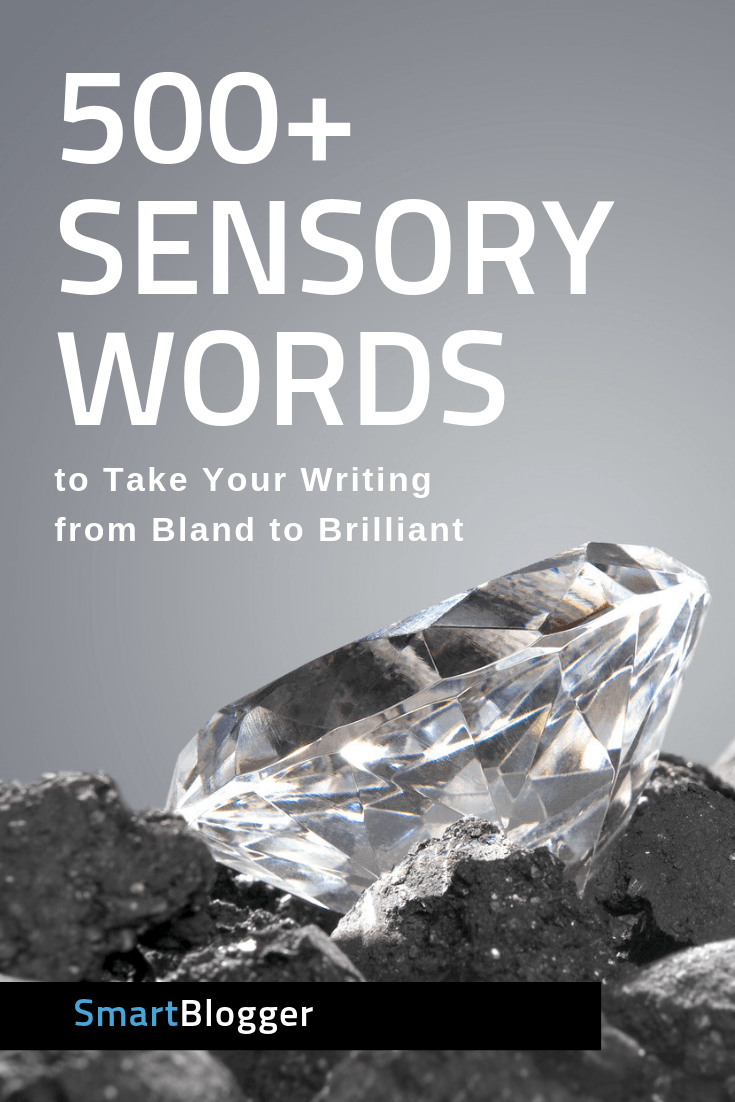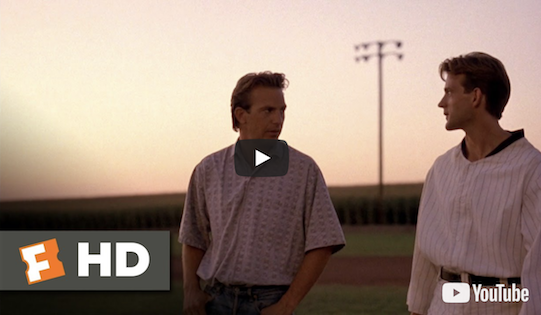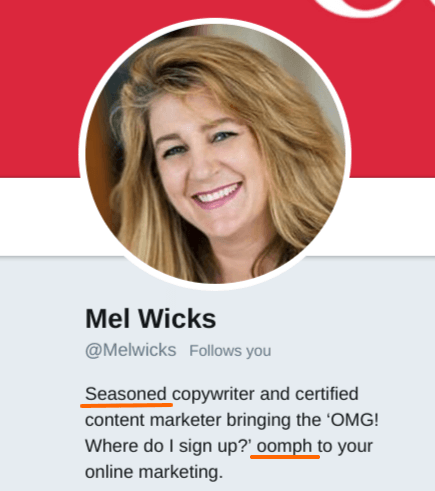It’s almost too easy.
By using sensory words to evoke sight, sound, touch, taste, and smell; smart and attractive writers just like you are able to make their words burst to life in their readers’ minds.
In this post, you’ll learn:
The science behind sensory details (e.g. why sensory words are so persuasive); The definition of sensory words (plus examples); How answering five simple questions will help you write descriptive words that pack your content with sensory language; 500+ sensory words you can incorporate into your own writing (right now).
Let’s dive in.
Back to Top The Colossal Power of Sensory Details
Remember the final scene in Field of Dreams when Ray Kinsella has a catch with his dad?
You can smell the grass on the field.
You can hear the sound of the baseball hitting their gloves.
And you can feel Ray’s years of guilt melting away as he closes his eyes, smiles, and tosses the ball back to his dad.
(Be honest. You’re crying right now, aren’t you?)
Field of Dreams made you feel like you were in Ray’s shoes, on his field, playing catch with dad.
The scene creates such a vivid experience for many viewers that whenever they think of playing catch, this scene will come up alongside their own childhood memories.
Here’s why:
When you paint a strong scene in your audience’s mind, you make it easier for them to pull it back up from their memory. You’ve essentially bookmarked it for them so they can easily find it when something — a sight, a smell, a sound — reminds them of it.
That’s the power of content that incorporates sensory details.
And this power isn’t limited to cinema classics capable of making grown men cry. For centuries, literary giants have been packing their prose with powerful words that evoke the senses:
“Cry ‘Havoc,’ and let slip the dogs of war; That this foul deed shall smell above the earth With carrion men, groaning for burial” — William Shakespeare (circa 1599)
In addition to The Bard, authors like Maya Angelou, Edgar Allan Poe, and Charles Dickens excel at sensory language. So do literally every famous poet you learned about in school.
And that begs the obvious question…
Back to Top Why are Sensory Details so Effective?
Short answer:
Our brains handle sensory words differently than ordinary words.
In a 2011 study published in The Quarterly Journal of Experimental Psychology, experts found that our brains process “tangible” (i.e. sensory) words faster than other words.
And in a study published for Brain and Language in 2012, psychologists found that a certain part of our brain is “activated” when we read sensory words.
In other words:
So, we know why sensory details are powerful. And we know writers have been tapping into their power for a long, long time.
Now let’s define them and go over a few examples:
Back to Top What are Sensory Words?
Sensory words are descriptive words — using imagery, they describe how we see, hear, touch, taste, and smell the world around us.
Let’s break each one down:
#1. Sight Sensory Words
Words related to vision describe the appearance of something (its color, size, shape, and so on).
Examples of visual words:
Her golden hair looked disheveled thanks to the gust of wind. He was a towering presence. I ordered a large orange juice, but the waiter brought me a teeny-tiny glass the size of a thimble.
→ Click here to unfold the full list of Sight Sensory Words.
Angular Azure Billowy Black Bleary Bloated Blonde Blue Blurred Blushing Branching Bright Brilliant Broad Brown Brunette Bulbous Bulky Camouflaged Chubby Circular Colorful Colorless Colossal Contoured Cosmic Craggy Crimson Crinkled Crooked Crowded Crystalline Curved Dark Dazzling Deep Dim Dingy Disheveled Distinct Drab Dreary Dull Dusty Elegant Enchanting Engaging Enormous Faded Fancy Fat Filthy Flashy Flat Flickering Foggy Forked Freckled Fuzzy Gargantuan Gaudy Gigantic Ginormous Glamorous Gleaming Glimpse Glistening Glitter Glittering Globular Gloomy Glossy Glowing Gold Graceful Gray Green Grotesque Hazy Hollow Homely Huge Illuminated Immense Indistinct Ivory Knotty Lacy Lanky Large Lavender Lean Lithe Little Lofty Long Low Malnourished Maroon Massive Miniature Misshapen Misty Motionless Mottled Mountainous Muddy Murky Narrow Obtuse Olive Opaque Orange Oval Pale Peered Petite Pink Portly Pristine Prodigious Purple Quaint Radiant Rectangular Red Reddish Rippling Rotund Round Ruby Ruddy Rusty Sabotaged Shadowy Shallow Shapeless Sheer Shimmering Shiny Short Silver Skinny Small Smudged Soaring Sparkling Sparkly Spherical Spotless Spotted Square Steep Stormy Straight Strange Striped Sunny Swooping Tall Tapering Tarnished Teeny-tiny Tiny Towering Translucent Transparent Triangular Turquoise Twinkling Twisted Ugly Unsightly Unusual Vibrant Vivid Weird White Wide Wiry Wispy Wizened Wrinkled Wrinkly Yellow
#2. Sound Sensory Words
Words related to hearing often describe the sound they make (known as onomatopoeia), but this isn’t always the case.
Examples of hearing words:
He had a big, booming voice. The sound of screeching tires was soon followed by the deafening sound of a car horn. As I peeked under the bed, the cackling laughter coming from the closet made the hairs on my arms stand up.
→ Click here to unfold the full list of Sound Sensory Words.
Babble Bang Barking Bawled Bawling Bellow Blare Blaring Bleat Boom Booming Bray Buzz Buzzing Cackle Cackling Chatter Chattering Cheer Chiming Chirping Chuckle Clamor Clang Clanging Clap Clapping Clicking Clink Clinking Cooing Coughing Crackle Crackling Crashing Creak Croaking Crow Crunch Crunching Crunchy Cry Crying Deafening Distorted Dripping Ear-piercing Earsplitting Exploding Faint Fizzing Gagging Gasping Giggle Giggling Grate Grating Growl Grumble Grunt Grunting Guffaw Gurgle Gurgling Hanging Hiss Hissing Honking Howl Hubbub Hum Humming Hush Jabber Jangle Jangling Laughing Moaning Monotonous Mooing Muffled Mumble Mumbling Murmur Mutter Muttering Noisy Peeping Piercing Ping Pinging Plopping Pop Purring Quacking Quiet Rant Rapping Rasping Raucous Rave Ringing Roar Roaring Rumble Rumbling Rustle Rustling Scratching Scream Screaming Screech Screeching Serene Shout Shouting Shrieking Shrill Sigh Silent Sing Singing Sizzling Slam Slamming Snap Snappy Snoring Snort Splashing Squawking Squeaky Stammer Stomp Storm Stuttering Tearing Thudding Thump Thumping Thunder Thundering Ticking Tingling Tinkling Twitter Twittering Wail Warbling Wheezing Whimper Whimpering Whine Whining Whir Whisper Whispering Whistle Whooping Yell Yelp
#3. Touch Sensory Words
Touch words describe the texture of how something feels. They can also describe emotional feelings.
Examples of touch words:
Two minutes into the interview, I knew his abrasive personality would be an issue if we hired him. With a forced smile, I put on the itchy Christmas sweater my grandmother bought me. The Hot Pocket was scalding on the outside, but ice-cold in the middle.
→ Click here to unfold the full list of Touch Sensory Words.
Abrasive Balmy Biting Boiling Breezy Bristly Bubbly Bubby Bumpy Burning Bushy Chilled Chilly Clammy Coarse Cold Cool Cottony Crawly Creepy Cuddly Cushioned Damp Dank Dirty Downy Drenched Dry Elastic Feathery Feverish Fine Fleshy Fluff Fluffy Foamy Fragile Freezing Furry Glassy Gluey Gooey Grainy Greasy Gritty Gushy Hairy Heavy Hot Humid Ice-Cold Icy Itchy Knobbed Leathery Light Lightweight Limp Lukewarm Lumpy Matted Metallic Moist Mushy Numbing Oily Plastic Pointed Powdery Pulpy Rocky Rough Rubbery Sandy Scalding Scorching Scratchy Scummy Serrated Shaggy Sharp Shivering Shivery Silky Slimy Slippery Sloppy Smooth Smothering Soapy Soft Sopping Soupy Splintery Spongy Springy Sputter Squashy Squeal Squishy Steamy Steely Sticky Stifled Stifling Stinging Stony Stubby Tangled Tapered Tender Tepid Thick Thin Thorny Tickling Tough Unsanitary Velvety Warm Waxy Wet Woolly
#4. Taste Sensory Words
Taste words are interesting. Though they can describe food, they’re often used in comparisons and metaphors.
Examples of taste words:
It’s a bittersweet situation. Her zesty personality caught Karl’s eye. The scrumptious jalapeno poppers comforted Karl after his bitter rejection.
→ Click here to unfold the full list of Taste Sensory Words.
Acidic Appetizing Bitter Bittersweet Bland Buttery Charred Contaminated Creamy Crispy Delectable Delicious Doughy Earthy Fermented Flavorful Flavorless Floury Garlicky Gingery Gritty Hearty Juicy Luscious Medicinal Mellow Melted Nauseating Nutritious Nutty Palatable Peppery Pickled Piquant Raw Refreshing Rich Ripe Runt Savory Scrumptious Stale Sugary Syrupy Tangy Tart Tasteless Unripe Vinegary Yummy Zesty
#5. Smell Sensory Words
Words related to smell describe — yes, you guessed it — how things smell. Often underutilized, sensory words connected with smell can be very effective.
Examples of smell words:
The pungent smell was unmistakable: someone in this elevator was wearing Axe Body Spray. No matter the expiration date, it was clear from its rancid stench the milk had gone bad. The flowery aroma was a welcome change after the elevator and milk incidents.
→ Click here to unfold the full list of Smell Sensory Words.
Ambrosial Antiseptic Aroma Aromatic Briny Citrusy Decayed Decomposed Doggy Fetid Floral Flowery Foul-smelling Fragrant Gamy Gaseous Horrid Inodorous Malodorous Mephitic Musky Musty Odiferous Odor Odorless Old Perfumed Piney Polluted Pungent Putrid Rancid Rank Redolent Reeking Scent Scented Sickly Skunky Smell Smoky Stagnant Stench Stinky Sweaty Tempting
Note on Taste and Smell:
Because they’re closely related, some sensory words can be used for both taste and smell. Examples: fruity, minty, and tantalizing.
→ Click here to unfold the full list of Taste and Smell Sensory Words.
Acrid Burnt Fishy Fresh Fruity Lemony Minty Moldy Mouth-watering Rotten Salty Sour Spicy Spoiled Sweet Tantalizing
Back to Top Sensory Details: Examples in the Wild
Imagine the following headline came across your Twitter feed:
How to Avoid Using Boring Stock Photo Images in Your Content
Would you click it?
Better question…
Could you read the headline without falling asleep?
The answers are probably “no” and “heck no.”
Now imagine you saw this headline:
Much better, right?
The simple addition of the sensory word “cringeworthy” changes the tone of the entire headline. Instead of yawning, you’re thinking of an awkward or embarrassing moment you really don’t want to relive.
Let’s look at a few more modern-day examples of sharp people using sensory language to spruce up their content:
Using Sensory Words in Author Bios
I’ll pick on me for this one.
Here’s the author bio I used for one of my first-ever guest posts:
Kevin Duncan is the owner of Be A Better Blogger, where he helps people become the best bloggers they can be.
Now look at the author bio my friend Henneke wrote for Writer’s Block: 27 Techniques to Overcome It Forever:
Henneke Duistermaat is an irreverent copywriter and business writing coach. She’s on a mission to stamp out gobbledygook and to make boring business blogs sparkle.
My bio is devoid of sensory words (or any interesting words at all, if we’re being honest).
Henneke’s is chock full of them.
Her bio is interesting.
Mine is boring.
The lesson? Add at least one sensory word to your author bio.
Using Sensory Words in Social Media Profiles
Some people opt for brevity when writing their social media profiles, and that’s fine.
But if you want your Twitter profile (or Facebook, Instagram, or any other social media profile) to stand out from the crowd, sprinkle in a sensory word or two.
Like so:
Mel Wicks is a veteran copywriter who knows a thing or two about the effectiveness of descriptive words, so she uses them to spice up her Twitter profile.
Here’s an example from my badly-neglected Instagram account:
“Enchanting” and “adorably-jubilant” are wonderful sensory words — so wonderful, it’s a shame they’re wasted on a profile no one sees.
Look at your own profiles and see if there’s a place to add a sensory word or two. They’ll help your profile jump off the screen.
Heck, see if you can use enchanting and adorably-jubilant.
They deserve to be seen.
Using Sensory Words in Introductions
The opening lines of your content are so important.
If you’re a student, your opening sets the tone for your teacher (who we both know is dying to use his red pen).
If you’re an author, your opening can be the difference between someone buying your book or putting it back on the shelf in favor of one of those Twilight books (probably).
And if you’re a blogger, writer, content marketer, or business; your opening can hook the reader (increasing dwell time, which is great in Google’s eyes) or send them scurrying for the “back” button.
It’s why we put such an emphasis on introductions here at Smart Blogger.
Sometimes our openings hook you with a question.
Sometimes we strike a note of empathy or (like this post) focus on searcher intent.
And sometimes we give you a heaping helping of sensory words:
Imagine you’re sitting in a lounge chair on the beach, staring out over the glittering sea, the ocean breeze ruffling your hair, listening to the slow, steady rhythm of the waves.
In the above opening for How to Become a Freelance Writer and Get Paid $200 – $1K per Post, Jon Morrow uses sensory language to set a scene for the reader.
And it’s highly, highly effective.
Using Sensory Words in Email Subject Lines
Like you, your readers are flooded with emails.
And with open rates in a steady decline, people are trying anything and everything to make their email subject lines stand out:
Emojis; Capitalized words; All lowercase letters; Two exclamation points; Clickbait that would make even BuzzFeed go, “that’s too far, man.”
You name it, people are trying it.
Want a simpler, far-more-effective way to help your emails stand out from the crowd?
Add a sensory word.
Brian Dean loves to include words like “boom” in his subjects:
The folks at AppSumo and Sumo (formerly SumoMe) regularly feature descriptive words in their subjects and headlines.
Here’s one example:
Read more: smartblogger.com









